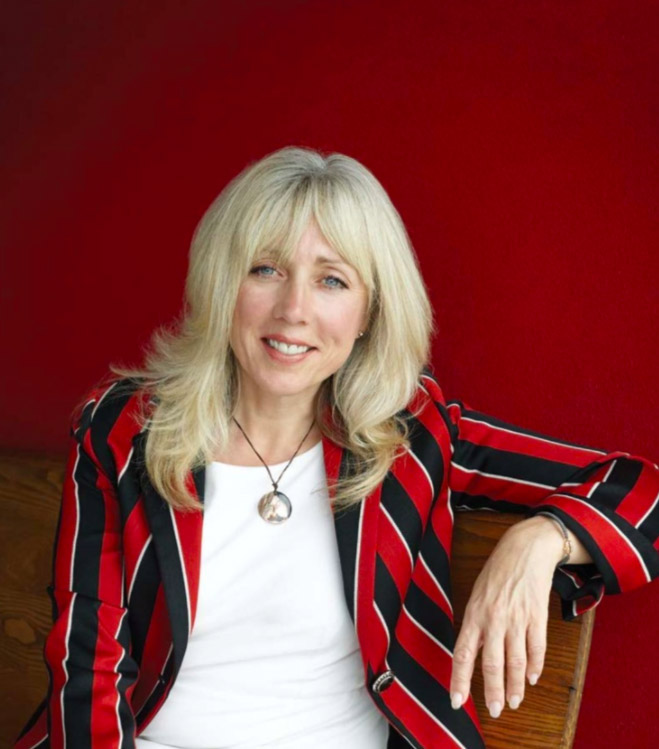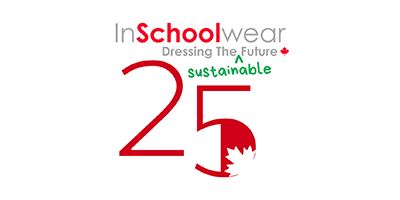
Glen Herbert
Editor/Writer, Our Kids Media

We know intuitively that companies are made up of people, not buildings and banks, though we may be prone to forget that sometimes. Should you ever need one, Kirstin Broatch is a particularly good reminder. Owner and CEO of InSchoolwear, I met with her recently at her office in Oakville, Ontario, in a complex that includes operations, distribution, and a regional store. As everyone, she’d been responding to the pandemic. The store, which would normally be bustling at this time of year, was admitting customers one at a time by appointment.
Despite it all, Broatch’s spirits were undimmed. “I always say never waste a disaster!” she says, partly joking and partly not. “You are going to learn something.” An ability to weather challenges gracefully has been one of the things that has gotten her to where she is. She founded InSchoolwear after attending a sales party for a children’s clothing brand—the sales model was similar to Tupperware—and came away thinking, “I can do better than that.”
She meant that in every way: designing, producing, and promoting quality clothing for children. So, she did it. She created designs, hired people to sew, and recruited two of her friends to be the nascent sales team. Product in hand, they sold out the first offering in ten days, then went back and did it again. A friend of hers was starting her two daughters at Clanmore, a Montessori school, and they arrived on the first day wearing matching dresses from those first lots. The principal, Grace Kidney, asked where she had got the dresses, and the next day called Broatch asking, “‘Would you design a uniform for us?”
Up until that point Broatch had been working as a dance teacher (a pair of well-loved ballet slippers hangs on a pin board behind her desk even today). She admits that, at least on the face of it, her options were limited. “I was a ballerina. What the heck can you do with a ballerina? And I had three kids under four.”
“But the thing that I was good at, from when I was a child,” she says, ”was making clothes. You know how people can sit at a piano and play anything, even though they’ve never had a lesson? Or people can cook? I can’t do any of those things. Nothing. But I can look at anything and know how to make it.”
Keep perfecting
Broatch remembers vividly when Kidney called to ask if she could make uniforms. She describes the moment as an epiphany, one in which she suddenly knew what she was going to do for the rest of her life. She then got to work, and after a period of knocking on doors—“back in those days you had a phone and a fax machine. That was it.”—she had a quarter of a million dollars of business and was preparing to open her first store.
Admittedly, school uniforms don’t display the breadth of design and expression that retail fashion does, nor do they occupy a similar space in the marketplace. “Uniforms you get to keep perfecting,” says Broatch. She says that it’s about gradual improvement, taking what exists and bringing it forward to meet changing needs and tastes. You take a blazer and add an inch to the sleeve, you bring in the tailoring of a shirt, you remove buttons from the cuff of a jacket. (This last is a bugbear: “They keep banging on the desk. All day long! It’s just irritating.”) “I love following the trends,” she says, particularly those of teen fashion, if doing it in more reasoned increments, keeping the identity clear. “You’re not changing things out like the Gap would, changing things out every six weeks.” With uniforms, you’re designing for the longer term, one that in some cases, as with Appleby College, includes a long history as an institution.
That doesn’t mean she resists change, or lacks a keen desire to innovate, to be sure. It just means that innovation comes in different ways. InSchoolwear was the first producer in the industry to use barcodes to track items from production through order fulfillment. It was the first to launch a website and, later, the first to create an online store. It was the first to offer buttons in the image of the school crest; the first to add Lycra to traditional trousers, and to offer them in a broader range of sizes. “It’s all the same grey, it looks all the same,” says Broatch, “but everybody can pick what’s right for them. You still have a traditional trouser, but with a cut that the teenage boys are happy to wear.” They offered shoes and then added a 3D scanner in each of the stores to ensure correct sizing. “It does a full scan of your feet,” she says, gesturing to what looks like a piece of the base of a Dance Dance Revolution arcade game. “So that’s an area I’m going to build. Looking after children’s feet.”
More recently, Broatch has pioneered the use of sustainable fabrics. “My new push is eco.” Using environmentally friendly materials, producing stock in more sustainable ways, while meeting the needs and preferences of a market that doesn’t appreciate any sudden movements. “It’s not about biodegradable,” she says, knowing that in other industries “eco” and “biodegradable” are synonymous. With uniforms, conservation is a concern, though durability is as well. “They can roll them up and use them as goal posts,” she says while showing me a line of blazers made from recycled water bottles. “They are children. These are not adults going to work. They are wearing their uniform, they shouldn’t have to worry about it.” Cotton makes things feel good, polyester makes things keep their shape. “And if you can switch out, and make the polyester from recycled bottles, you save energy, you don’t use crude oil,” and the benefit is clothes that last longer and don’t need to be replaced as often.
Stay true to the identity
Broatch hopes to offer a complete product line built from sustainable fabrics by 2025, and by all available metrics she’s well on her way. The challenge is less about creating the clothing—the resources exist, the production facilities are up and running—than it is in demonstrating value and, ultimately, encouraging adoption. Through her own enthusiasm for the products, she’s been turning eyes and ears. “Feel that” she says, showing me a pleated skirt made of a blend of lycra and post-consumer plastics. “Feels great, doesn’t it?” It does. If you’ve yet to experience the feel of post-consumer plastic on the skin, you’ll be surprised.
Appleby College was one of the first schools to move to sustainable fabrics. It’s not a decision that was made in haste, or based on a single concern, but the product of an ongoing dialogue around how traditions meet the present moment. “You just keep working on it,” says Broatch. “I went all the way back through their archives to find out where [the current designs] came from. What were the colours?” In researching them, she found that the school colours meant more than most people, if anyone, knew. “One is Oxford University and the other is Cambridge University. Bingo. There’s a reason whoever started that school picked them, but people over the years lose track.” Broatch sees that kind of research as essential to the task of dressing students well. “Looking back ... finding the path.” Being able to say with confidence, “this is your colour, and this is why,” then sourcing the dye lot and staying with it.
Deliver value
“Life’s a journey,” she says, thinking of her early days. “When the door opened, I went through it. I absolutely knew I wanted to do it.” Designs change, times change, requirements change, though Broatch believes a core commitment to value should remain through it all. “If you’re buying a high-end product, the value should be there. You should get what you pay for.”
InSchoolwear currently supplies more than 200 private schools across the country, from Montessori schools to leading day and boarding schools. There are 9 physical stores, and online shopping has grown as well, now accounting for 40 percent of sales. The institutional memory is long, represented in part by racks and racks of uniforms that Broatch has collected over the years from schools in Canada, the US, and the UK. It’s a working archive collected over decades. “It’s like a baby to me.” She recalls a dusty pink uniform with a grey blazer for a boys’ school in Surrey, England. “Who would let you do dusty pink over here? And knee highs. You don’t get to wear long pants until you’re older! But it’s stunning. Why would you want your school to be the same as everyone else's? You wouldn’t. You’d want to stand out.”
“The two things that I love are fashion, bringing in enough fashion that the kids want to wear it.” The other thing? “And saving the planet.” There are some transferable skills from the world of dance, she can see in retrospect. “The costume design, the deadlines. If you’re putting a show on, the curtain’s going up, you’ve got to have your costume. There’s a lot of similarities, even if you don’t think there is. And everybody wants their child to feel special.” The uniforms lasted, the colours matched, the shirts kept their shapes.
Behind a desk at the entrance to the warehouse there’s a saying written in large, cursive letters on a whiteboard that reads “Happiness is who surrounds you, not what.” After reading it out loud, Broatch says, “I put that up when I was on my own here for eight weeks,” during the COVID shutdown. “Eight weeks, just me and the dog.” The only person allowed on site, she personally received millions of dollars of uniforms, learning how to operate the pallet truck in order to do it. She admits that it felt a bit like starting over. “But you have to go back. That’s how I keep up to date. You have to go back and walk in as if you are the customer. And never stop learning.” And she hasn’t.
“It’s nothing about school uniforms,” she adds. “Absolutely nothing.” It’s about feeling good, delivering value. It’s about respecting traditions while also meeting the present moment. Done well, uniforms get children into the experience of learning—allowing them to feel special, part of something bigger than themselves—while not limiting it, allowing them the freedom to be exactly who they are. ”It’s all to do with people.”
 |
| Kirstin Broatch | |
| 905-334-4545 | |
| [email protected] | |
| inschoolwear.com |